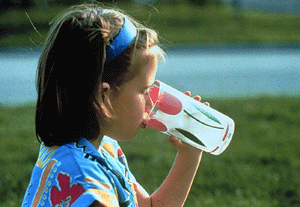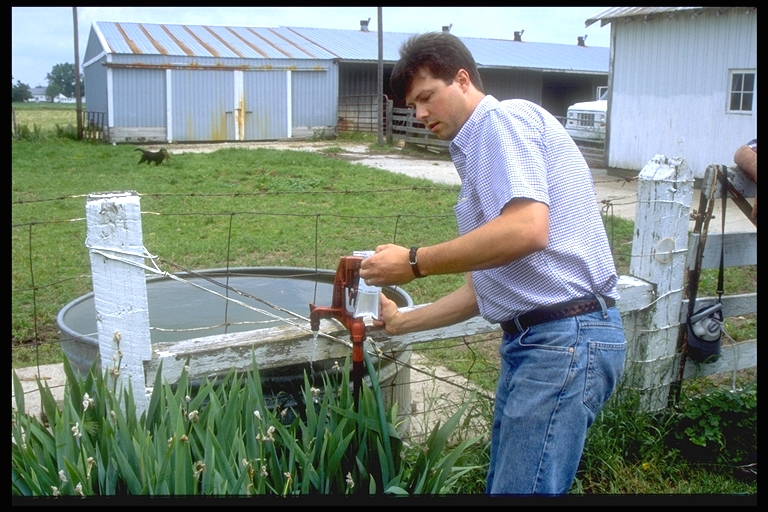What contaminants should I be concerned about in my drinking water?
 There is
no general test for water quality. Water must be tested for specific
substances, but testing for every possible contaminant is unnecessary
and expensive.
There is
no general test for water quality. Water must be tested for specific
substances, but testing for every possible contaminant is unnecessary
and expensive.
Your first concern
should be to provide your family with a safe source of water, so testing
for contaminants that may pose a health threat comes first. Bacteria,
nitrate, and lead are the most likely health-based contaminants. Private
well ownersshould test annually for total coliform bacteria and nitrate.
Although they are not the only potential problems, the presence or absence
of bacteria or nitrate often indicates the general safety of your water
supply. These contaminants can only be identified through testing because
both are typically invisible, odorless, and tasteless.
Contaminants with potential adverse health effects are called "primary contaminants", while those that may cause an unpleasant odor, taste, or color but have no known health effects are called "secondary contaminants". Drinking water standards have been established by scientists within the United States Environmental Protection Agency (EPA) for most of the primary contaminants. These standards for contaminants with potential adverse health effects are known as "MCL"s (for Maximum Contaminant Level) and are enforceable by law. Standards for nuisance contaminants are called "Secondary MCL's" and are not enforced. For more information on contaminants see the Purdue Extension publication Why & How to Test Home Water Supplies
Nitrate
Nitrate is found
at low levels from naturally occurring sources, but high levels (>
2 ppm) usually indicate human-caused contamination. Possible sources
of nitrate in ground water include septic systems, fertilizers (lawns
or agricultural), and animal wastes, either from improperly managed
lagoons or land application at high rates. Nitrates can be toxic to
infants, and anyone with infants or expecting a baby in the home should
have their well water tested for nitrates. Nitrate
and Groundwater in Indiana provides more information on incidence
of nitrate in Indiana and methods of prevention. The same information
is available in pdf format in the Purdue Extension publication WQ-27.
Lead
Lead in home drinking water usually comes from solder used to join plumbinb pipes or from lead pipes used in some older homes. Water is generally lead-free as it leaves the treatment plant, but by the time it comes out of the faucet, it may have dissolved lead from pipes or solder. To evaluate the highest levels of lead exposure, take a sample from the tap after water has been held in the pipes for several hours or overnight. Water samples can be analyzed at many laboratories in Indiana. (See Water Quality Testing Laboratories.) If lead exceeds the 0.015 mg/l standard, the potential risk must be reduced, particularly if young children drink the water. Avoid using water that has sat in the pipes for several hours (overnight or other long periods) for cooking or drinnking. Never use water from the hot-water tap for cooking or drinking. Treatment methods for lead include reverse osmosis and distillation. See Lead in Drinking Water for more information.
Pesticides
Many people are concerned about pesticide contamination in ground water, although some of the most known pesticides have been detected in only 6.7% of wells in Indiana, with levels above the drinking water standard found in less than 0.1% (Wallrabenstein et al., 1994). Pesticides are much more likely to contaminate surface water supplies. Although there are very few private water supplies that use surface water in Indiana, many public water supplies do, including those serving Indiana's largest cities. Pesticides and the Environment explains how properties of pesticides and soil affect surface or ground water contamination.
Bacteria
Bacterial Contamination
of Household Water, Purdue University Water Quality Publication
#15
Well
Disinfection
If your well tests
positive for bacteria, one recommended solution is to shock chlorinate
the well and plumbing systems.
Follow this informative guide on well
disinfection from IDEM.
Purdue Extension publications you may find useful:

-
Interpreting Water Test Reports. Part One: Inorganic Materials.
-
If you test your well and find drinking water standard violations, here are publications on how to treat it:
For more information contact Jane Frankenberger (frankenb@purdue.edu)
References
-
Wallrabenstein, Laura K., Richards, R. Peter, Baker, David B., and James D. Barnett. Nitrate and Pesticides in Private Wells of Indiana. Indiana Farm Bureau Inc., 1994